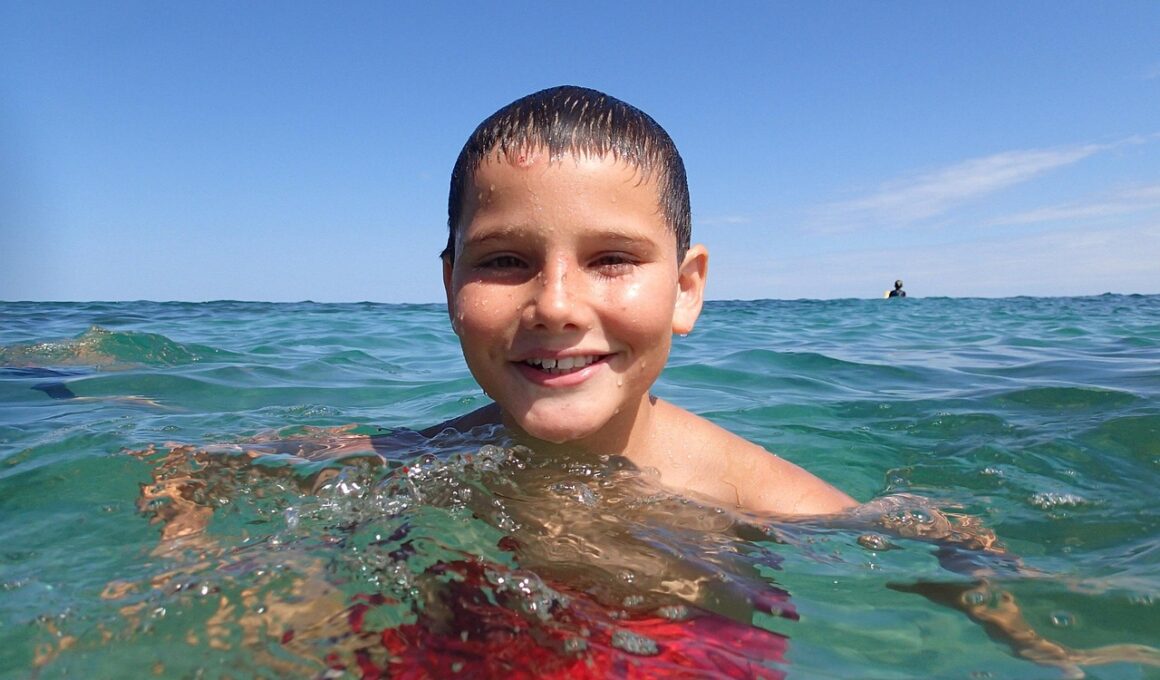How Swimming Helps Improve Kids’ Coordination and Strength
Swimming is an excellent activity for kids, providing them with numerous benefits for their physical and mental development. It encourages the use of various muscle groups, enhancing coordination and balance. As children float, kick, and stroke through the water, they develop their gross motor skills, which are vital for overall physical health. These movements require concentration and body awareness, fostering better motor coordination which can be beneficial in other activities. Furthermore, swimming helps improve strength through resistance exercises, as water is denser than air. The body must work harder to move through the water, promoting muscle development. Every swim stroke engages different muscles, enhancing upper and lower body strength. Additionally, swimming allows for the improvement of core stability, which is crucial for better athletic performance in various sports. Kids who swim often develop stronger muscles, improved posture, and enhanced agility. As they become more confident swimmers, they learn to navigate their movements in various aquatic environments. Overall, swimming provides a fun, engaging way for kids to stay active while significantly boosting their coordination and strength.
Swimming involves rhythmic movements which are crucial for coordinating various body parts. As kids swim, they learn to synchronize their arms, legs, and breathing, promoting a holistic approach to physical activity. This synchronization enhances their ability to multitask in other sports and everyday activities. Children cultivate better spatial awareness, allowing them to judge distances and movements accurately. In a swimming class, kids are often encouraged to participate in games. Such games help in refining their motor skills, and they also foster teamwork and camaraderie. Furthermore, as children immerse themselves in swimming sessions, they experience improved cardiovascular fitness. This fitness, in turn, multiplies their stamina and endurance, allowing them to engage in longer swimming workouts or other sports without fatigue. Importantly, water provides a safe environment for kids to practice strength-building exercises without the high impact associated with traditional sports. Overall, swimming serves as an invaluable activity in promoting kids’ physical literacy. By enhancing their coordination and strength, it prepares them for diverse physical challenges they may encounter in life.
Swimming also plays a significant role in building self-esteem and confidence in children. As they master swimming techniques, they gain a sense of accomplishment that is critical during developmental years. Overcoming challenges in swimming, such as learning a new stroke or overcoming fear of deep water, instills resilience. This builds a positive self-image that translates into other areas of life, including academics and social situations. In swimming classes, instructors often provide positive reinforcement, highlighting children’s progress and achievements. This affirmation encourages kids to set and achieve personal goals, fostering a lifelong love for physical activity. Swimming not only teaches essential life skills such as water safety but also encourages a healthy lifestyle. The results of swimming are visible not just in physical fitness but also in improved cognitive function. Studies show that regular physical activity, such as swimming, supports better concentration and cognitive performance. As kids swim, they are often better prepared to handle classroom demands. Thus, the benefits of swimming extend beyond mere physicality, enhancing overall development and promoting a well-rounded lifestyle.
Incorporating swimming into a child’s routine can set the foundation for a lifetime of healthy habits. Parents can facilitate this by enrolling their children in local swim programs, ensuring they learn proper techniques safely. Early exposure to swimming builds familiarity and comfort in water, reducing the risk of drowning while nurturing a lifelong skill. Furthermore, swimming provide opportunities for families to participate together, developing stronger family bonds. Swimming as a family can create cherished memories while instilling the importance of physical activity. Many public pools offer family swim times, where parents can supervise and engage with their kids in the water. This shared activity not only promotes fitness but also promotes communication and interaction within the family. With great emphasis on safety and fun, kids can thrive in a structured swimming environment. Lifeguards and instructors ensure adherence to safety protocols, creating a secure atmosphere where kids can learn with confidence. Moreover, as kids develop their swimming abilities, they may even consider joining swim teams or clubs, further enhancing their sense of belonging within a social environment.
The Health Benefits of Swimming
Swimming has countless health benefits, particularly for children. It serves as both an enjoyable activity and an effective workout, often engaging children in a way that doesn’t feel like exercise. Regular swimming sessions can lead to improved cardiovascular health, as it builds endurance and strengthens the heart. Enhanced lung capacity is another benefit of swimming, as the controlled breathing techniques practiced during swimming contribute to respiratory fitness. Swimming is low-impact, making it suitable for kids of all sizes and physical abilities. This low-impact nature decreases the chances of injury, often seen in several land-based sports. Moreover, swimming helps in weight management, especially in children, promoting a healthy lifestyle that can prevent childhood obesity. As kids swim regularly, they can develop healthier eating habits, understanding the necessity for nourishment that supports their physical activities. This connection between exercise and nutrition helps kids cultivate lifetime habits that positively impact their well-being. Lastly, swimming benefits mental health by reducing anxiety and promoting relaxation. The calming effects of water can soothe the mind, helping children manage stress more effectively.
In conclusion, swimming is a multifaceted physical activity that offers immense benefits for kids’ coordination and strength. These benefits extend beyond just physical health, impacting emotional, social, and cognitive development. By engaging in swimming, children enhance muscle strength, coordination, and overall fitness while having fun. Activities such as swimming teach children how to set personal goals and work towards them, establishing a sense of commitment from a young age. Parents play a crucial role in this journey, encouraging participation and exposing their children to swimming programs. As children learn to swim proficiently, they build self-confidence and resilience that can translate into various aspects of their lives. The social interactions within swimming classes promote teamwork and communication skills essential in today’s world. Thus, incorporating swimming into a child’s life not only develops physicality but also nurtures emotional intelligence. As they grow, these swimming experiences contribute to a well-rounded perspective on health, fitness, and leisure activities. Ultimately, fostering a love for swimming can pave the way for a healthy and active lifestyle that lasts well into adulthood.
Encouragement for Parents
Encouraging children to partake in swimming lessons from a young age can enhance their overall physical literacy and confidence. This engagement significantly influences their views on fitness and health as they grow older. Parents should seek community resources that offer classes specifically designed for children. Whether it’s private lessons, classes, or swim camps, the opportunities available can fit each child’s unique needs. Parents can also promote friendly competition by enrolling their children in local swim teams. This team environment not only enhances skills but also fosters a sense of camaraderie, helping children form lasting friendships. Swimming races or competitions boost confidence and a healthy competitive spirit. Parents should actively participate in this journey, attending swim meets or practicing with their kids. This involvement illustrates the importance of commitment and hard work. Parents can also create a swimming routine that encourages consistency and familiarity, ensuring that swimming becomes an integral part of their children’s lives. Ultimately, the benefits of swimming are abundant, and with encouragement, children can thrive in their aquatic pursuits while reaping the numerous physical and mental health advantages that come along.
As children learn to swim, experts recommend establishing safety protocols at home and in public pools. Teaching kids about the water safety rules is crucial for their well-being. Parents should educate kids on how to assess swimming environments and identify safe areas for play. Additionally, parents should model safety practices by actively watching their children while they swim. Regular reminders about the importance of never swimming alone can reinforce good habits. When children understand the significance of safety measures, they develop an awareness that helps them make informed decisions. Also, teaching them about the different types of bodies of water, such as rivers or lakes, is essential. These areas can present unique challenges not found in pools, and familiarity with each environment promotes responsible behavior. Awareness of diving boards and unexpected obstacles in pools serves as another significant component of water safety education. Ensuring children wear the right swimming gear, such as life jackets where necessary, further enhances their safety. Swimming lessons should encompass not only techniques but also comprehensive safety instruction, ensuring that kids leave with a strong foundational understanding of safe swimming habits.


